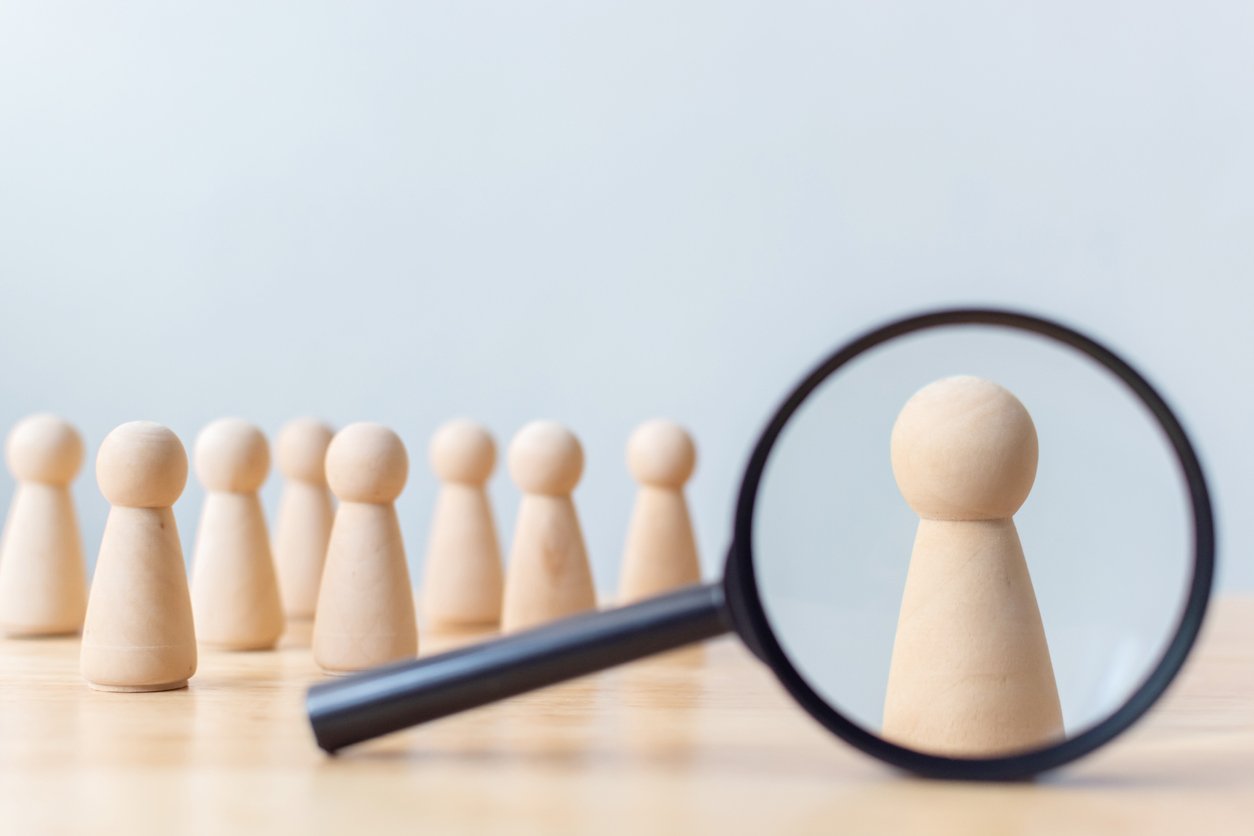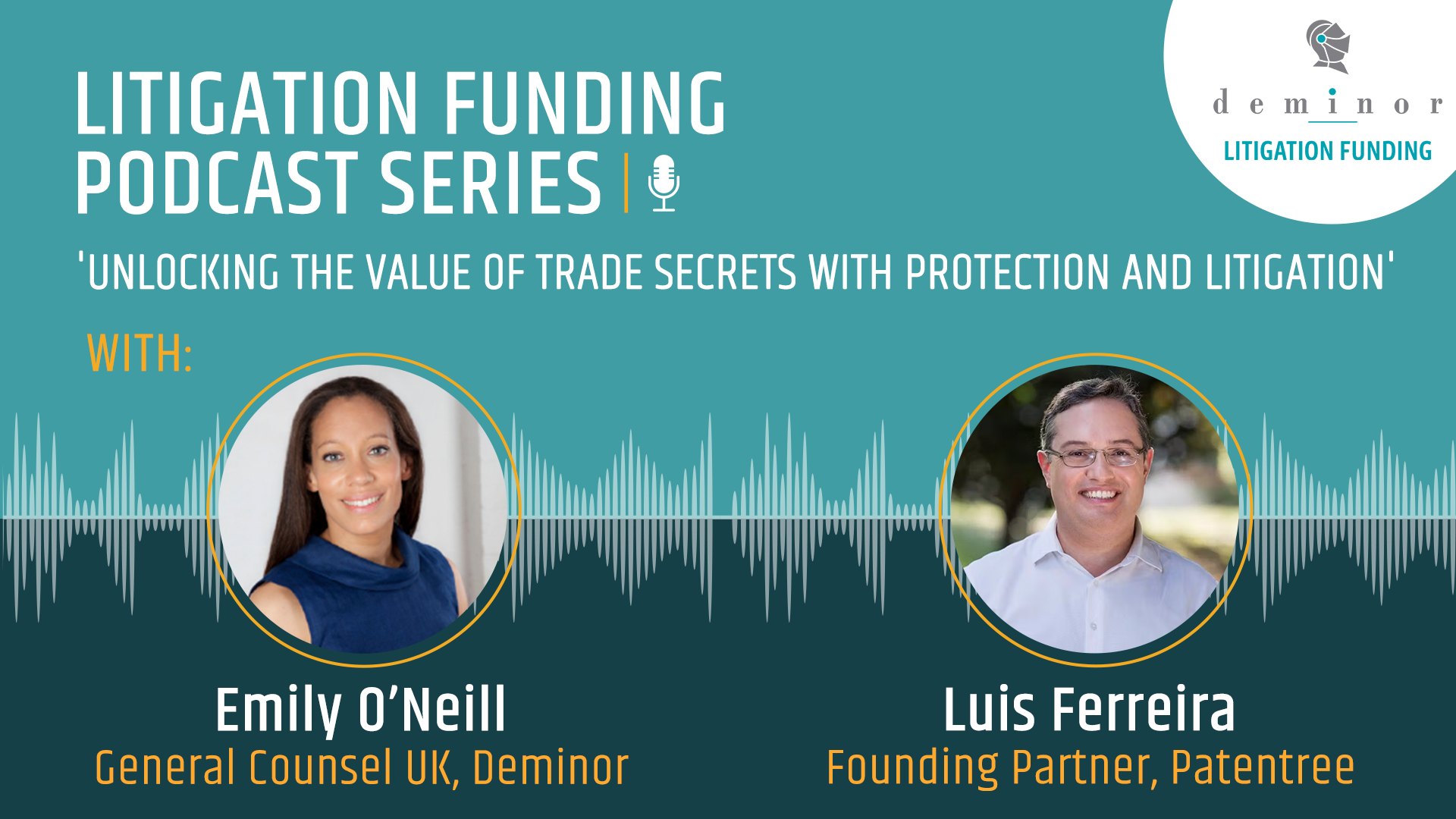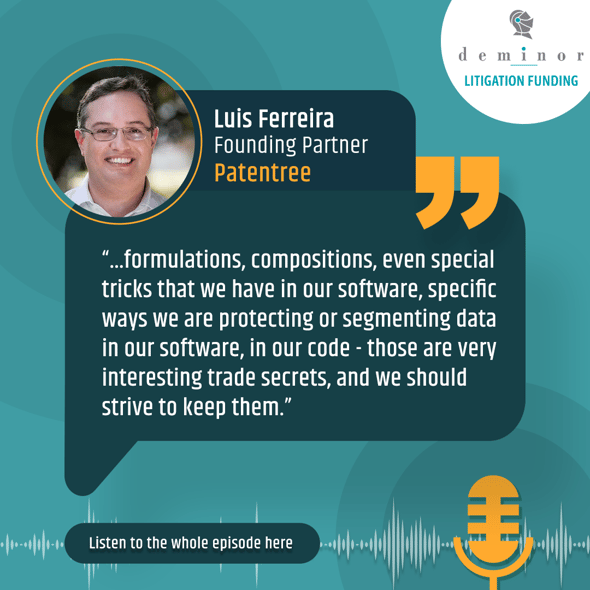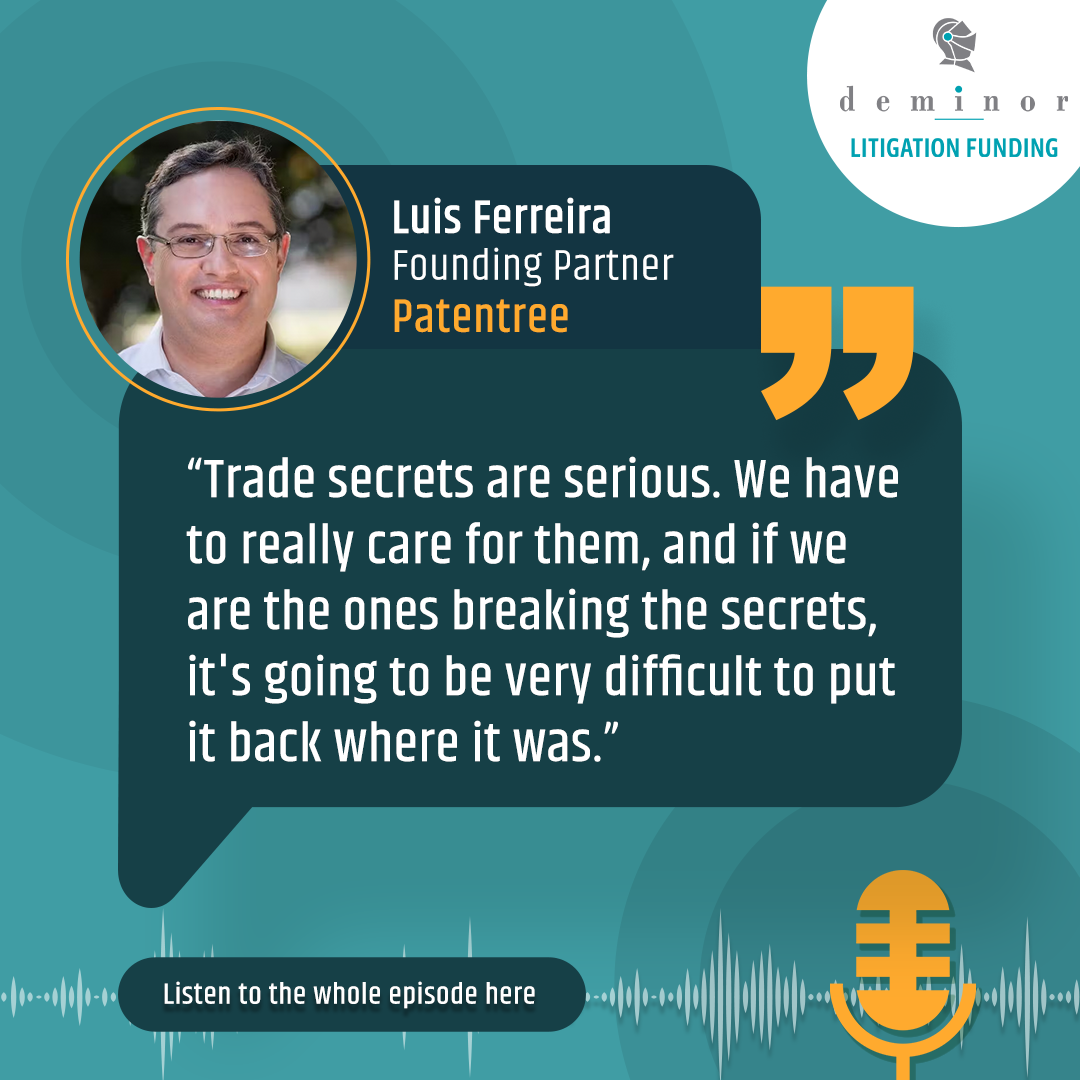In this podcast series, Emily O'Neill General Counsel UK for Deminor Litigation Funding, undertakes interviews with global professionals to discuss different aspects of litigation and litigation funding.
Deminor welcomes you to join this conversation as we summarise the key elements of the conversations between Emily O'Neill and these experts, as captured in the podcast transcripts below.
Podcast Preface:
Deminor General Counsel UK, Emily O'Neill (EON), speaks with Luis Ferreira (LF), and Founding Partner at Patentree, a leading intellectual property consultancy supporting inventors and companies protect their intellectual property.
In this interview with Emily, Luis explores the changing landscape of intellectual property (IP) protection, particularly the growing trend of companies prioritising trade secrets over patents. The discussion delves further into the rising awareness of the strategic value and effective management of trade secrets alongside the practical challenges of securing and valuing these intangible assets.
Podcast Transcript:
EON – There is some discussion that companies are looking more to trade secrets than patents to protect some of their technical IP. Have you seen this trend among your clients?
LF – Yes and no.
In fact, what we have seen is that people are much more aware. There is a much stronger realisation of what trade secrets companies own: the proprietary and confidential information with value already in their possession. People seem to be much more aware these days, and that creates this impression, maybe this feeling that trade secrets are increasing. But they were always there; maybe we were just not paying attention. They were hidden under the rug, inside of the drawer, and now they’re coming out. We know them. We can measure them. We can protect them. We can manage them.
Of course, trade secrets are, in a way, more difficult to enumerate than patents or other IP rights which are registered. They have a number, they have a date, and they even have a pretty certificate showing when they were registered. There is no such thing for trade secret secrets. So, we have to actively pursue them and know them. But I think it’s just companies getting more aware of what they have.

EON – I think that’s true. There’s more of an awareness. But in my experience in some cases where company budgets are under stress, you see discussions go: “let's save the money on patent filing and protect it as a trade secret.”
The thought process isn't so much there in terms of how to protect it and what the steps are that you need to take to protect something as a trade secret but more let’s save money.
Have you seen that kind of discussion?
LF – We have. Of course, there is always a compromise. Where are you going to spend your time? Where are you going to spend your money? Where are you going to invest your people? And then you have to invest wisely these days; there's always a cost of opportunity. But we cannot forget that we are always generating IP. We're always generating knowledge. This knowledge, a lot of times, goes into trade secrets – not actively managing them, not actively taking care of them. That means we could be losing them.
Of course, trade secrets are usually cheaper to protect than patents, for example. Trade secrets have a lower cost for protection, which is basically the reasonable measures we take to protect them. And that does involve some time and money, but it's not particularly expensive if you do it right. If you don't do it right, it could be very costly indeed. So, I would say honest work. We have to do it correctly; we have to do it plainly. It's just normal business, I would say, these days I would not do anything else.
EON – It's helpful to take a practical example on what can be a trade secret. So, for example, if a company buys a competitor's product and breaks that down and replicates it and then publishes what it finds in that in the market.
Can that be a trade secret?
LF – The issue here is that we tend to forget that trade secrets sometimes can be easily re-engineered, so it can be easily circumvented. We tend to be overconfident in our capability to protect the secret. We believe nobody will find out; nobody will be able to re-engineer/reconstruct our secret. And that confidence is usually over-placed. We can all be a little bit more nimble, a little bit more humble in that regard.
Trade secrets: like formulations, compositions, even special tricks that we have in our software, specific ways we are protecting or segmenting data in our software, in our code - those are very interesting trade secrets, and we should strive to keep them. Usually, processing trade secrets the way we do, the way we produce the specific steps we take, takes a lot of time and will not be visible from the outside. In those cases, let's keep them, let's protect that secret, and let's make sure people are aware that only key people have access to that information. That way, we can preserve that information within our confidentiality remit.
However, we also have to be very humble in that we overestimate. We've seen that happening lots of times when companies say we don't want to patent this idea; we want to keep it a secret; this process is our special sauce, and nobody will find it. And then, just a couple of years later, someone is actually patenting something very similar. And then, at best, we can try to say, ‘Oh, we are the priority.’ But proving a priority is quite challenging. We are proving it to our own benefit. It's always very challenging to get to the proper credibility of that evidence. We can find ourselves in a very tight spot where we are tasked to prove that our own idea was indeed ours – and that's challenging.
EON – Exactly. When you have to prove prior use, it means what you can do with that use going forward is much more limited. So it's not just the step of showing that you were using; it's ‘you can only use within the scope of what you've already been doing’. And so that cuts off future business development.
EON – Looking at times you've seen trade secrets released or misappropriated, in what circumstances have you seen companies disclose or lose control of their trade secrets?
LF – I can discuss a couple of cases where the company only got in touch with our firm when things had already escalated; thankfully, we've not seen outrageous cases of loss of confidentiality. I think people do tend to be careful. We have not had any kind of extreme malice from, I don't know, disgruntled employees and things like that we hear in the news. I think our cases are much more day-to-day cases in working with others. Typically, people approach collaborations from a positive viewpoint, from a constructive starting point and then things sometimes go in the wrong direction.
For example, a company was collaborating with a large multinational. They were sharing information, they were sharing products, and they had some discussions that they were going to file some IP protection in the future. They already had some discussions they were going to sign a non-disclosure agreement. In this case, it was an MTA, material transfer agreement, because they were exchanging product samples already. Then, when they signed the MTA, we finally realised that the other side had already filed a patent application with the information that was being discussed in the collaboration. Was it a bad faith issue? Was it a mistake? We're not sure, but it happens.
In another case we were collaborating with a car manufacturer - these are usually large companies, they are very sophisticated. And the same thing happened. We were discussing a PhD thesis, and there was plenty of confidential information in that discussion. We ended up finding out that the car manufacturer had filed a patent application three weeks after that discussion. Of course, the details were not all there. There was lots of technical information that was not in that discussion. Curiously, of course, the inventor who appeared in that patent application was not in the discussion with us. So, it's almost impossible to prove the chain of the confidential information until it reaches the patent application by the other party. And then we're in a very difficult position.
Trade secrets are serious. We have to really care for them, and if we are the ones breaking the secrets, it's going to be very difficult to put it back where it was. If there is something to be shared, to be discussed, usually, a patent application will be the norm. And that way we can protect those discussions. Otherwise, if it's a secret, if it's not protected as a secret, it's not a secret.
We just have to be very mindful of that.
EON – I think it's about identifying what are the really truly valuable secrets and what is confidential information, and then not disclosing the trade secret unless you have to.
In the manufacturer example, that's quite a difficult position because even if you know that there has been some sort of dealing that shouldn't have happened or misappropriation, trying to prove that, particularly if the inventor on the application isn't one of the people who were part of the discussion, is quite difficult.
When I look at cases from a funding point of view, it's hard to piece together, actually, where things have gone wrong. If we need to look at starting an action and then looking at disclosure, for example, where that's possible, then that's quite a leap of faith to invest in litigation when you don't actually really know what the merits of the case are. So, good internal processes are key.
EON – Looking at internal processes in Portugal, do companies have any protection if they disclose confidential information without an NDA in place?
LF – Not much, really. Of course, there are some tools like unfair competition and anti-competitive practices. There is some law in that respect. And there is the general principle in civil law countries, a little bit like common law countries, where good faith is assumed in all business acts. Still, these are makeshift protections. There's nothing like protecting a trade secret under the common law of confidence.
We even have a directive, and it's been fairly well implemented in Portugal and other EU countries. If we have that directive on our side, at least it's not so bad. But if we are not following it, and if we are sharing information in a non-confidential way, I think it will be under unfair competition or anti-competitive practises. It was very difficult to prove that we were working in a good faith way and the other party was acting in bad faith when certainly, on the look of it, we were the ones breaking the confidentiality. We were the ones not treating the subject matter with the due confidentiality that it deserved. It's going to be very difficult for any reasonable decision-maker, any reasonable judge, to come after this and say, ‘Oh no, of course, you were the ones in bad faith, you were the ones in good faith, and the other party was in bad faith’.
It's going to be really challenging to do that. So if there is a protection, we have to use it. There's not much room there. Otherwise, it's almost impossible to obtain any protection if we are going against what the law specifies. But I think there are ways to do it. It's not so difficult if we treat our information as confidential. If we sign the proper documents, at least we have that legal protection on our side.
Of course, a confidentiality agreement is not everything. We have to know the other party. We have to develop a relationship where we share information, perhaps gradually, and we get in response to demonstrating trust. Then, we develop a relationship step by step, and then we share more gradually until we reach a level where we are both confident in each other. It's almost like a marriage. And this is what really happens in a fruitful business relationship. This goes beyond confidentiality agreements and NDAs, MTAs, and CDAs; those are just tools. Most of the time, we use these tools for Entrepreneurs and inventors to show due diligence; they even sign all this paperwork. But that does not guarantee that information will not flow - we know that.
Even more importantly, I would say the most interesting part is that VCs will not sign any non-disclosure agreement. They don't sign anything. If they're kind to us, they'll say: ‘Protect yourself; you protect your IP the best way you can do it. If you have to file a patent application, just do it of course, before you talk to us, but we're not going to sign anything. Just present your idea/your project. We will not take any obligation other than any other public person will take in listening to your project presentation.’ So, the more interesting the party is, the more dangerous the other party is, and we have to find ways to protect our IP.
So if it's a secret, it's a secret. We don't talk about secrets. It's like we don't talk about Bruno. We don't talk about secrets. Otherwise, it's not a secret. And if it's not a secret, then you have to find some other way to protect it. Patent application, utility model application, copyright protection, for example, for source code. It depends.
EON – What are your three top tips for companies to maintain strong protection for their trade secrets?
LF – The most important point is to map them. You need to list them. You have to know, ‘What are your trade secrets?’ Is it special software? A special piece of source code that segments and maps customer interactions? Or is it a special pharmaceutical formulation? Or a dosage trick? Or secret quantities? We have to know them. And if we don't know them, how can we protect them after that?
I think it's a matter of education. We have to educate our innovators, our entrepreneurs, and our start-ups that these things matter. Usually, we go there, and then everyone has access to everything. So we ask them and they say: ‘We have this special source code. No one has been able to do this before.’ And we ask who's got access to this code? ‘Oh, everybody.’ Do you mean everybody in the company? ‘Oh yes, of course, everybody.’ You mean even the cleaner?’ Well, yes, if she switches on the computer, she will have access to it.’ Oh boy! So, education and then, finally, we have to use the tools.
The tools are not so difficult. The law does prescribe that we should take reasonable measures. So, typically, the usual stuff; work contracts, onboarding/offboarding employees. Those moments should reflect our trade secret work. Also, our IP work and property entitlement ownership. Those things should be taken care of. So typically, when you onboard an employee to a special project, you may want to tell him to inform him or her that they will be in touch with trade secrets in that new project as a special project or when they are offboarding from that project, or even leaving the company. You should declare that ‘this stuff was secret, and we expect you to protect this secret in your future work and life.’ And, of course, having a couple of clauses in work contracts always helps – it reinforces the law, it makes it clearer, and it improves communication. In some cases, you can even go a little bit beyond the law in asking for a little enhancement in protection.
Those would be my three points for start-ups. Know your secrets, Educate yourself, and, of course, Use the tools you have.

EON – If you've lost your trade secrets and you want to claim some damages, how would you value a trade secret?
LF – It's very difficult. Even if a product is patented, sometimes we can correlate the value of the patent with the product, but with trade secrets, we have no such luck. It's really difficult mapping the market to the trade secret. Of course, the traditional approaches work fine. We're talking about damages. So you can talk about what was our loss of revenue, what were the infringers’ profits? What were the profits of the person or people that got abusive access to our trade secret – what was their profit in their illegal actions? Another criterion often used is what would be a common royalty/market value for that information?
But even if we identify these three numbers, the problem is then mapping those three numbers to the trade secret. In what respect, in what way? To what extent was the trade secret the essential driver of that loss of revenue, of those infringement profits? Because then we see very interesting arguments saying, well, we were just better at marketing than you guys. Our product execution, our execution was better than yours. It was not a matter of the trade secret. And then we are in a tough situation where we want to map a number onto a trade secret.
It's not so easy. I believe, in fact, that the larger cost is an opportunity cost. It is what we could have done, and what options were cut out from us? What future was disappearing because we lost that trade secret? And that is impossible to quantify. Of course, we can say, okay, the infringer profited a couple of million euros from this fine, but how many millions did we lose in our future, in our future plans, in our future developments, and that cannot be recovered and even less quantified. It's very difficult in trade secrets to quantify loss.
Litigation Funding Podcast Series - Next Steps and Further Information:
Thanks for joining Deminor's Litigation Funding Podcast Series as we dive deep into core topics in funding litigation.
Keep a lookout for our upcoming conversations as Deminor General Counsel UK, Emily O'Neill, speaks with several more experts to get their insights into different aspects of litigation funding.
If you would like to connect with either Emily or Luis on LinkedIn, please click on the links below:
Emily O'Neill - Deminor General Counsel UK and Global IP lead
Luis Ferreira – Founding Partner, Patentree
***
Further Reading:
- https://www.deminor.com/en/case-studies/co-funder-proposes-sharing-of-litigation-funding-risk-to-leverage-deminors-in-house-due-diligence-capability
- https://www.deminor.com/en/case-studies/financing-assertion-of-patents-protecting-manufacturing-processes
- https://www.deminor.com/en/case-studies/telecoms-patent-assertion-multi-jurisdictional-campaigns
- https://www.deminor.com/en/case-studies/canadian-innovative-start-up-preparing-for-a-david-v-goliath-litigation-funding-battle
- https://www.deminor.com/en/case-studies/whats-the-risk-assessing-the-risk-of-counter-assertion-by-the-defendant-in-patent-litigation
- https://www.deminor.com/en/case-studies/overstepping-the-mark-litigation-funding-trade-mark-infringement
- https://www.deminor.com/en/case-studies/lights-camera-action-recovering-damages-for-infringement-of-rights-in-a-short-film
- https://www.deminor.com/en/case-studies/recovering-damages-for-stolen-software-through-litigation-funding
- https://www.deminor.com/en/case-studies/funding-in-the-pharma-sector-/-investing-in-a-case-where-litigation-is-already-ongoing









